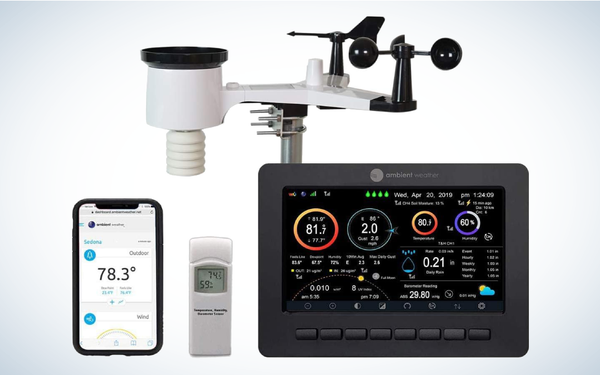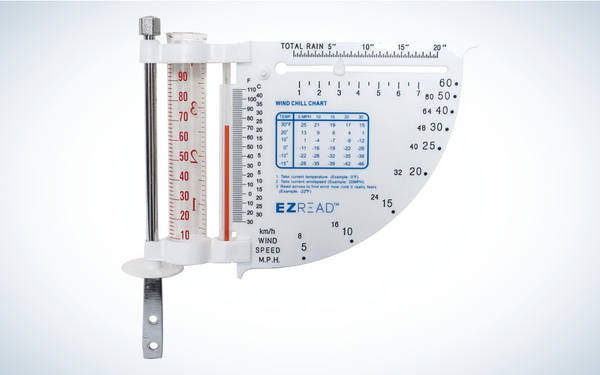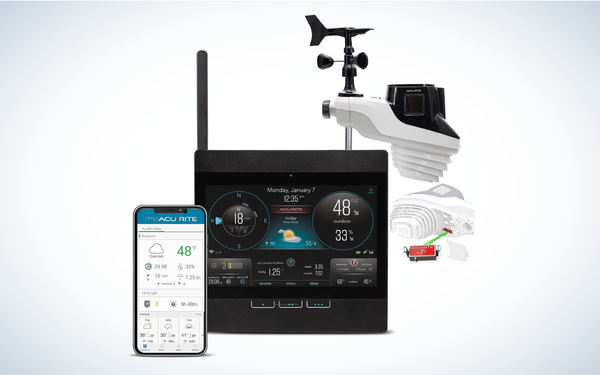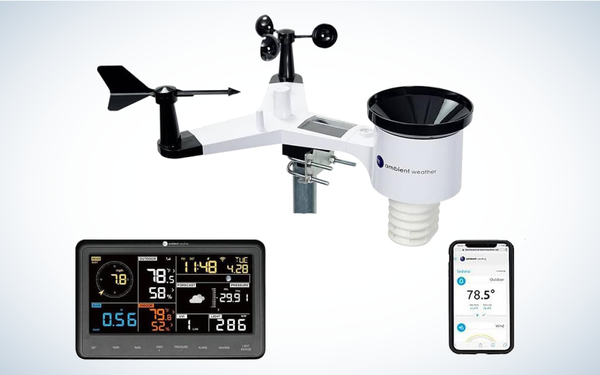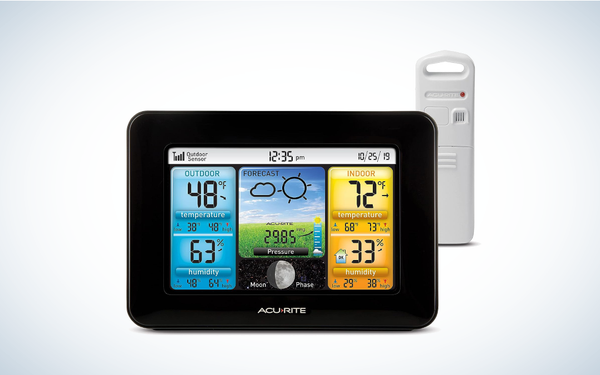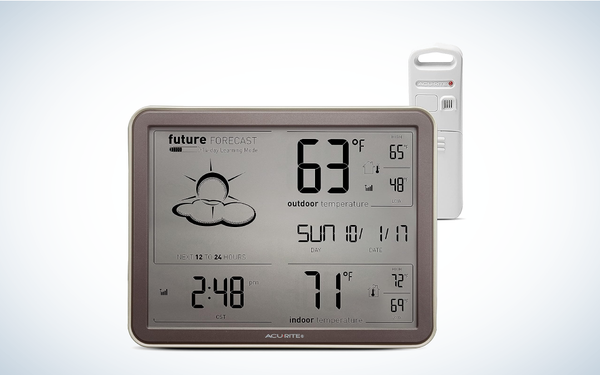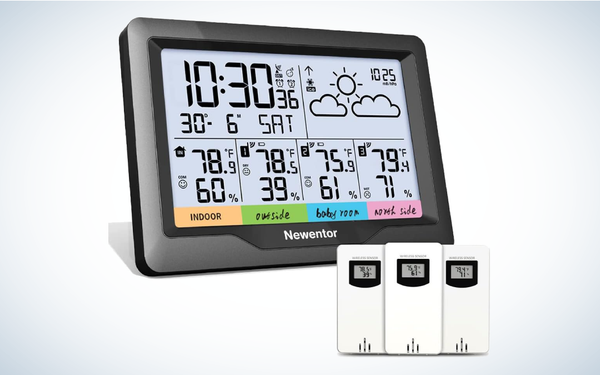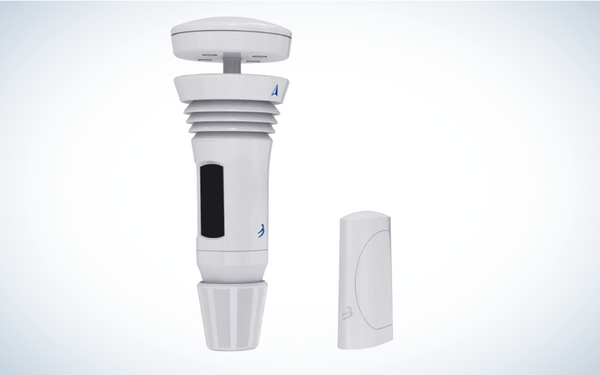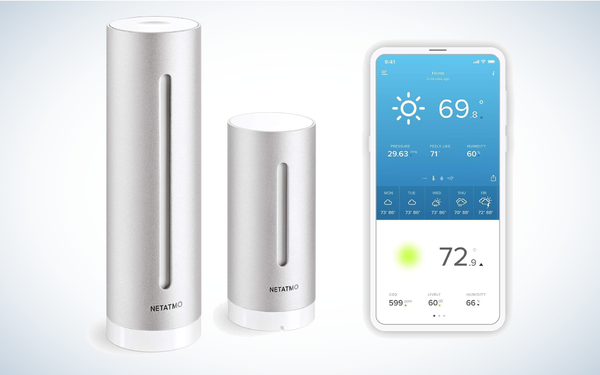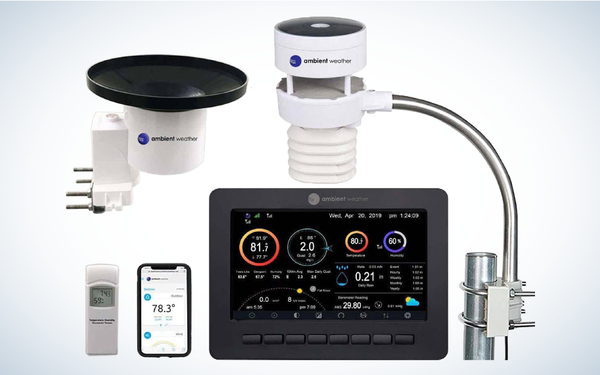



We may earn revenue from the products available on this page and participate in affiliate programs. Learn more ›
Home weather stations first caught my eye when my wife and I were watching Jim Cantore braving yet another hurricane. These systems go far beyond our own meager skills at reading the skies. They allow us to see into the future—even if just a wee bit—and let us make plans based on reliable predictions of what’s to come in terms of temperature and precipitation. They measure everything from wind speed and wind chill to humidity and rainfall. Some even track lightning strikes.
Of course, absorbing endless hours of TV weather forecasts doesn’t make anyone an expert, and it can be bewildering to navigate the endless choices in home weather stations. That’s where we come in. We’ve analyzed the best home weather stations below, taking into account the most desirable features, as well as the learning curve necessary to get up to speed on them.
I’ve been something of a weather geek since I was a kid. I always paid close attention to forecasts and even learned a bit about how to read natural signs indicating changing weather patterns. As an adult, I spent several years working as a detective, and I found that weather data actually came in quite handy several times, like when I was investigating car crashes. As a result, I have a pretty good handle on what information is actually useful when it comes to what home weather stations can provide.
As I sorted through the dizzying number of options, I paid close attention to the instruments offered by each, as well as the accuracy of those instruments, ease of installation and setup, and overall performance.
Specs
Pros
Cons
There just isn’t much that the Ambient Weather WS-2000 can’t do. The system has sensors for wind speed and direction, temperature, humidity, rainfall, even UV and solar radiation—all in one sensor array that’s very easy to mount. You can install the array up to 330 feet away from the receiver thanks to its line of sight. That said, 100 feet is more realistic due to obstacles and terrain.
The color tablet displays all of the pertinent information in an easy-to-read format. It doesn’t just give you raw data, either. It helpfully calculates a number of things for you, including wind chill, heat index, sunrise and sunset times, and moon phase. It’s designed to keep you up to date and informed on what to expect.
Specs
Pros
Cons
This is about as low-tech as it gets, and that’s not a bad thing. Not everyone wants or needs all the bells and whistles. The Headwind 5-in-1 will give you all of the current readings you might want, including wind speed as well as temperature. With only a couple of parts to assemble, getting your weather station up and running takes just a few minutes.
It comes with predrilled holes for mounting on a fence post or similar surface. You’ll want to position it where you’ll be able to easily see it, as there’s no indoor display console where you’ll receive the data. All in all, this is a great entry-level and budget-friendly option for a home weather station.
Specs
Pros
Cons
AcuRite is the top-selling weather station brand in the United States, and for good reason. Their equipment works incredibly well. The AcuRite Atlas Professional model monitors eight different measurable conditions and uses them to give you a personalized 12-hour forecast. Not only that, with the My AcuRite app, you can monitor these conditions from anywhere, whether you’re traveling or just running errands.
This weather station also features a direct-to-Wi-Fi display with an auto-dimming brightness setting, as well as programmable alarms for each measured condition. The sensor array is powered by four AA batteries (alkaline or lithium), while the indoor console comes with a power adapter and uses three AAA batteries for backup.
Specs
Pros
Cons
With a brilliant easy-to-read LCD screen, you won’t miss a thing with the Ambient Weather WS-2902. An enhanced Wi-Fi connectivity option allows you to transmit your station’s data to the world’s largest weather station network, providing data for others to utilize. You can also access your data via phone, tablet, or computer.
This system monitors indoor and outdoor conditions, including temperature and humidity in both locations, as well as outdoor wind direction and speed, rainfall, barometric pressure, and much more. It will also calculate heat index, wind chill, and dew point.
Specs
Pros
Cons
This AcuRite home weather station uses self-calibrating technology to provide you with a weather forecast with pinpoint accuracy. The wireless sensor hangs outside and transmits data to the console, where that information is run through weather prediction algorithms. The end result is an incredibly accurate forecast for the next 12 to 24 hours.
The color display is easy to read, even at a distance. The Intelli-Time internal clock never needs setting and will automatically adjust for Daylight Savings. The system monitors indoor temperature as well as outdoor, too.
Specs
Pros
Cons
As the name suggests, the AcuRite self-learning weather station self-calibrates to your precise location and uses that information along with collected data to provide you with an accurate forecast up to 12 hours ahead. Setup is a piece of cake—just install two AA batteries into the sensor, then hang it outside on a nail or hook up to about 300 feet from the console. Let the two synchronize and you’re good to go.
The internal atomic clock sets itself for both time and date. You’ll see the indoor temperature displayed, courtesy of the sensor built into the console. One note: The system takes up to 14 days to learn the weather patterns in your area.
Specs
Pros
Cons
This Newentor home weather station will provide you with accurate temperature and humidity readings for both inside and out. You can add up to three total sensors if you’d like to monitor several locations at once. With the clock and dual alarms features, you can use this to not only monitor weather conditions but also to wake up in the morning.
Stickers are provided so you can label the display to indicate the location of the sensors, such as one for the garden, another for the backyard, the basement, and the kitchen. You can monitor temperature as well as humidity in these locations, as well. It’s a great basic system if you don’t want to spend more than $200.
Specs
Pros
Cons
You can install the Tempest weather system in less than five minutes, getting you up and running in no time. It can integrate with your smart home and you can use the data it collects to turn any of your connected appliances or electronics on or off, whether that’s the front yard sprinklers or your house fans.
The Tempest app will talk you through connecting to your home’s Wi-Fi network and getting your home weather station configured. After that, it will provide you with lightning and rain alerts, temperature, humidity, barometric pressure, and more.
Specs
Pros
Cons
What really sets the Netatmo Weather Station apart from other home weather stations on our list is that it tracks air quality along with the more mundane measurements like humidity and temperature. This is a great feature for family members who might be sensitive to changes in air quality, such as those who suffer COPD or allergies. The system will even alert you if conditions are bad enough to warrant ventilating the home.
Once the system is connected to your home Wi-Fi, you can access it by voice command through Alexa or Siri. Just ask for the temperature or other data and you’ll hear exactly what you need.
Specs
Pros
Cons
The Ambient Weather WS-5000 is a pricey option, no question about it, but this home weather station is absolutely loaded with features. The all-in-one sensor array has no moving parts to wear out or fail, but it still provides exceptionally accurate data. It is entirely smart home ready and will easily connect to Google Home, as well as Alexa, IFTT, and more.
The sensor array provides real-time updates every five seconds and measures everything from wind speed and direction to temperature, humidity, and rain. While it will optimally transmit up to 1,000 feet line of sight, as a practical matter you can get up to about 300 feet in most locations.
A home weather station can be a valuable tool for any household, allowing you and your family to tailor plans and activities based on what’s predicted for the immediate future. There are a few things to keep in mind as you run through the various options available.
First and foremost, determine what functions you truly want or need in a home weather station. All of them will provide temperature and humidity readings, but if you want wind speed, rainfall, wind chill, and other more advanced data, you’ll need to be a little more selective.
It’s important to think about your budget, of course. Spending a few hundred dollars on a system might not be practical for everyone, particularly those who are just dipping a toe into this hobby and aren’t sure yet if they’ll stick with it.
Accuracy is somewhat subjective, at least in terms of practical need and use. If you’re just looking for something that will tell you if you need to add rain gear to your fishing loadout on Sunday, you probably don’t need something that’s accurate to 1/100th of a percentage.
Connectivity is one more consideration. Some of these home weather stations will connect to outside services, such as Weather Underground, and transmit weather data for collection. What this means to the end user is they can then turn around and access data collected from other stations in their area, giving them a more accurate idea of what’s on the way.
Q: How do home weather stations measure humidity?
Humidity refers to the amount of water vapor in the air. A home weather station measures this with a hygrometer. While there are a few different kinds of hygrometer, the capacitor type is most commonly used for home weather stations. Its sensor is usually placed near the temperature sensor, as the information from both is used to calculate dew point.
Q: Where is the best place to put a home weather station?
To get the most accurate readings, keep the sensor away from heat sources like chimneys or air conditioning units, as well as out of direct sunlight. The temperature sensor should be about 4-5 feet from the ground. If possible, keep it at least 50 feet away from bodies of water and trees to ensure the humidity readings aren’t compromised.
Place the anemometer, which measures wind speed, as high as possible—ideally at least 7 feet above all surrounding structures. Finally, set your home weather station on grass or short bushes or shrubs. Avoid asphalt or concrete as these types of surfaces can impact the readings.
Q: How accurate are home rain gauges?
Most home rain gauges are accurate to within 1-2 percent. Accuracy depends on a few factors, including the measurement markings on the gauge itself. If all you have to work with is 1/4-inch increments, then your measurements aren’t going to be as accurate as another gauge that uses more precise markers.
Using one of the best home weather stations to monitor conditions—both current and predicted—can make for a fun hobby. Personal weather stations like these can also be great holiday gifts. You can use them to teach others, particularly youngsters, about what causes various types of weather. You can also use the data when you’re making plans for outdoor activities or simply deciding what to wear when you leave the house in the morning. But, if you happen to see Jim Cantore strolling down the sidewalk, you might want to double-check the forecast, just in case.
For more than 125 years, Field & Stream has been providing readers with honest and authentic coverage of outdoor gear. Our writers and editors eat, sleep, and breathe the outdoors, and that passion comes through in our product reviews. You can count on F&S to keep you up to date on the best new gear. And when we write about a product—whether it’s a bass lure or a backpack—we cover the good and the bad, so you know exactly what to expect before you decide to make a purchase.

